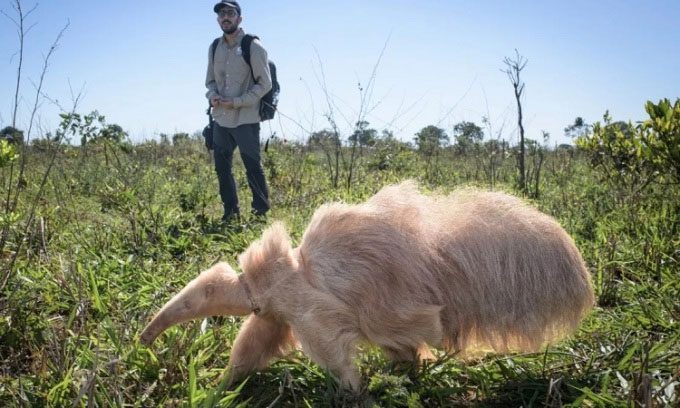The giant white anteater is at risk of being detected by predators or harmed due to excessive exposure to sunlight.
Conservationists have shared new photos of the last living albino giant anteater on Earth, believed to be at least one year old, Live Science reported on May 19. A research team from Anteaters and Highways (AHP), a long-standing project on anteater-vehicle collisions conducted by the Brazilian Wildlife Conservation Institute (ICAS), first discovered this unique animal in December 2022 on a farm in the state of Mato Grosso do Sul. They named it Alvin.

Alvin, the albino giant anteater in December 2022. (Photo: ICAS).
At that time, Alvin was clinging to its mother’s back, a common behavior among all young giant anteaters (Myrmecophaga tridactyla) under 10 months old. The researchers photographed the snow-white individual and equipped it with a GPS tracking device to monitor its movements in the future, according to a representative from AHP.
On May 10, AHP shared new images of Alvin on social media. The white anteater is now 1.5 meters long and weighs 14 kilograms, indicating it is over one year old and approaching full maturity. Alvin also received a new GPS collar as the old one no longer fit.
Albinism is a genetic syndrome that prevents animals from producing melanin, the pigment that gives color to their skin, fur, scales, and eyes. As a result, albino individuals appear completely white and have pink eyes. Their eyes and skin are very sensitive to light, which can lead to vision impairment and make them more susceptible to sunburn. Albinism is hereditary; both parents must carry a copy of the gene.
The main threat to most albino animals is the higher risk of predation due to their conspicuous coloration in their habitat. This seems to be true for the giant anteater. In August 2021, the AHP research team found the carcass of a nearly mature male albino giant anteater in the same area as Alvin. The remains showed signs of having been preyed upon.
“When we got there, it had already died, but we were able to collect genetic samples and send them to the lab for analysis,” said Dr. Débora Yogui, a veterinarian at AHP. By comparing DNA collected from the first albino individual with Alvin’s DNA, researchers can determine if they are related.
If Alvin and the deceased albino anteater are not directly related, this could reveal a dwindling gene pool due to inbreeding. The research team suspects this is a result of habitat destruction caused by human deforestation. The giant anteater is currently listed as vulnerable in the International Union for Conservation of Nature (IUCN) Red List.
The research team is concerned that even if Alvin survives predation, it may be adversely affected by excessive exposure to sunlight. Anteaters tend to spend the hottest part of the day in the shade due to their poor adaptation to extreme temperatures. However, deforestation has eliminated shaded areas, posing a significant problem for Alvin due to its sensitive skin. AHP researchers will continue to monitor Alvin’s development but will not intervene if it falls ill or is attacked by predators.


















































